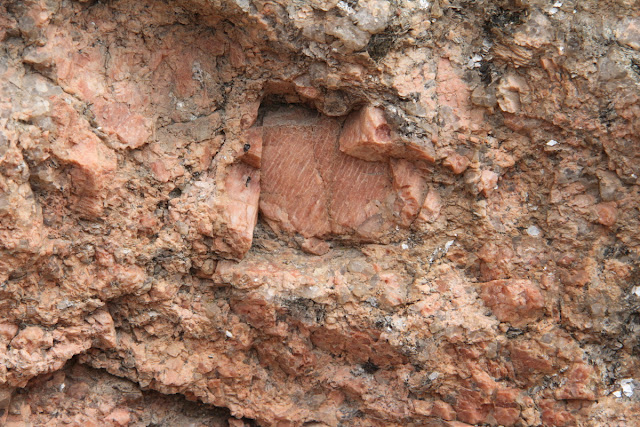In July, I traveled to some places in central Colorado that I had never been to before. Here is an account of my trip to the Royal Gorge of the Arkansas River and a scenic geologic drive north of Canon City called the Shelf Road.
This was the second place Jack and I visited that is in the footsteps of Lt. Zebulon Pike (see the previous posting of an account to the
Great Sands Dunes National Park). Pike was the first American to see the Royal Gorge of the Arkansas. I wonder why this expedition is not as famous as the Lewis and Clark expedition farther north? His orders were to do the same - explore the new boundary of the United States after the Louisiana Purchase. Hmm?
This is the bridge over the Arkansas River looking to the north. It has wooden planks on it so it rattles quite a bit when a vehicle drives over it.
The bridge over the gorge and the land surrounding it is owned by the municipality of Canon City (prounounced as both
cannon and
canyon). They operate the area as a kind of amusement park replete with all kinds of American kitsch, clowns, magic shows, and sky rides. A bit disheartening to see so much fluff in an otherwise fantastic landform.
For me the big attraction was the gorge itself. Here is a view to the northwest and the land beyond the gorge. This is a spectacular landform worthy of a visit but we did not find even one sign relating to the natural history of the area. A shame really and it explains why people like myself usually avoid visiting the area. In fact, as I thought about it, I know of very few people who have been here.
Here is one of the sky rides crossing the gorge
And a view of the Arkansas River below with the railroad tracks paralleling the river on river left. The story of how this fantastic rail line was built is told in a book called, "
Rival Rails" by Walter R. Borneman. You can read about that book
here. I found it to be a fascinating story as the ATSF and the DRG vied for rights to build through the gorge. The DRG eventually won that battle.
A view of the Royal Gorge in the upstream direction with the river and tracks at the bottom. At its deepest point the gorge is 1,250 feet deep. The rather flat surface on top of the gorge is curious. Perhaps this is an erosion surface from the Laramide (approximately 70 million years ago) or it could be a surface formed in the Precambrian that elsewhere in the west is called the Great Unconformity. For a fantastic and comprehensive explanation of the Great Unconformity, see a blog post by Jack Share
here.
You can easily see the sheer depth of the gorge in this view. The rock is called the
Pike's Peak Granite, although there are places where gneiss and other metamorphic rocks are also present. Formed just over 1,000 million years ago, the granite is an interesting rock to behold (see below).
A laerger view of the lip of the canyon and the Pike's Peak Granite
Close-up of river and railroad
The Pike's Peak Granite up close. A granite with crystals this large is technically called a pegmatite and these form when water in a magma facilitates the growth of large crystals.
A large felspar crystal in the granite can be seen, as well as the
perthitic texture within it (lines)
After leaving the Royal Gorge, we entered Canon City and then headed north on a dirt road towards Cripple Creek. We soon found that this road followed Four Mile Creek which brought us to the Garden Park Fossil Area. It was here that the famous "Bone Wars" of the 1870's was played out as paleontologists Edward Cope and Othniel Marsh battled each other for the most significant dinosaur find. Read about it
here.
We hiked a short distance to one of the old time quarries, set above the cliff in the red sediments. Note the obvious channel feature within the Morrison Formation at this locality. The dinosaurs would have found the riparian environments that coursed through this area to their liking. For a map of the Morrison paleogeography, see the map below from my book, "
Ancient Landscapes of the Colorado Plateau".
Paleogeographic map of the Morrison Formation, Brushy Basin Member
The Shelf Road continues north. We had heard that the road was quite narrow and not to be taken in wet weather (it was wet). However, we found it to be no problem and continued onward.
There was an excellent exposure of the Great Unconformity in the canyon. In fact, the "shelf" of the Shelf Road was built utilizing the contact between the Ordovician Manitou Formation (upper strata) and the Precambrian crystalline rocks below. I had never before seen the unconformtiy as expressed in Ordovician rocks as Arizona has absolutely none of this age.
View of the Shelf Road and its rocks
Jack touching the unconformity at a road cut along the Shelf Road.
Nice photo of the unconformity with a dike trending vertically through the crystalline rocks.
Foliated and very friable schist in the Precembrian rocks along the Shelf Road
As we neared Cripple Creek, we found that we were entering one of the West's great Gold belts. The nearby town on
Victor still has a working gold mine.




































